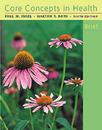Paul M. Insel,
Stanford University, School of Medicine
Walton T. Roth,
Stanford University, School of Medicine
| *physical fitness | A set of physical attributes that allows the body to respond or adapt to the demands and stress of physical effort.
|
 |
 |
 |
| cardiorespiratory endurance | The ability of the body to per-form prolonged, large-muscle, dynamic exercise at moderate-to-high levels of intensity.
|
 |
 |
 |
| muscular strength | The amount of force a muscle can produce with a single maximum effort.
|
 |
 |
 |
| muscular endurance | The ability of a muscle or group of muscles to remain contracted or to contract repeatedly for a long period of time.
|
 |
 |
 |
| flexibility | The range of motion in a joint or group of joints; flexibility is related to muscle length.
|
 |
 |
 |
| *body composition | The proportion of fat and fat-free mass (muscle, bone, and water) in the body.
|
 |
 |
 |
| cardiovascular disease (CVD) | A collective term for diseases of the heart and blood vessels.
|
 |
 |
 |
| endorphins | Brain chemicals that seem to be involved in modulating pain and producing euphoria.
|
 |
 |
 |
| neurotransmitters | Brain chemicals that transmit nerve impulses.
|
 |
 |
 |
| cardiorespiratory endurance (aerobic) exercise | Rhythmical, large-muscle exercise for a prolonged period of time; partially dependent on the ability of the cardiovascular system to deliver oxygen to tissues.
|
 |
 |
 |
| electrocardiogram (ECG or EKG) | A recording of the changes in electrical activity of the heart.
|
 |
 |
 |
| maximal oxygen consumption (MOC) | The body's maximum ability to transport and use oxygen.
|
 |
 |
 |
| target heart rate | The heart rate at which exercise yields cardiorespiratory benefits.
|
 |
 |
 |
| resistance exercise | Exercise that forces muscles to contract against increased resistance; also called strength training.
|
 |
 |
 |
| isometric exercise | The application of force without movement; also called static exercise.
|
 |
 |
 |
| isotonic exercise | The application of force with movement.
|
 |
 |
 |
| anabolic steroids | Synthetic male hormones used to increase muscle size and strength.
|
 |
 |
 |
| cross-training | Participating in two or more activities to develop a particular component of fitness.
|



 2002 McGraw-Hill Higher Education
2002 McGraw-Hill Higher Education